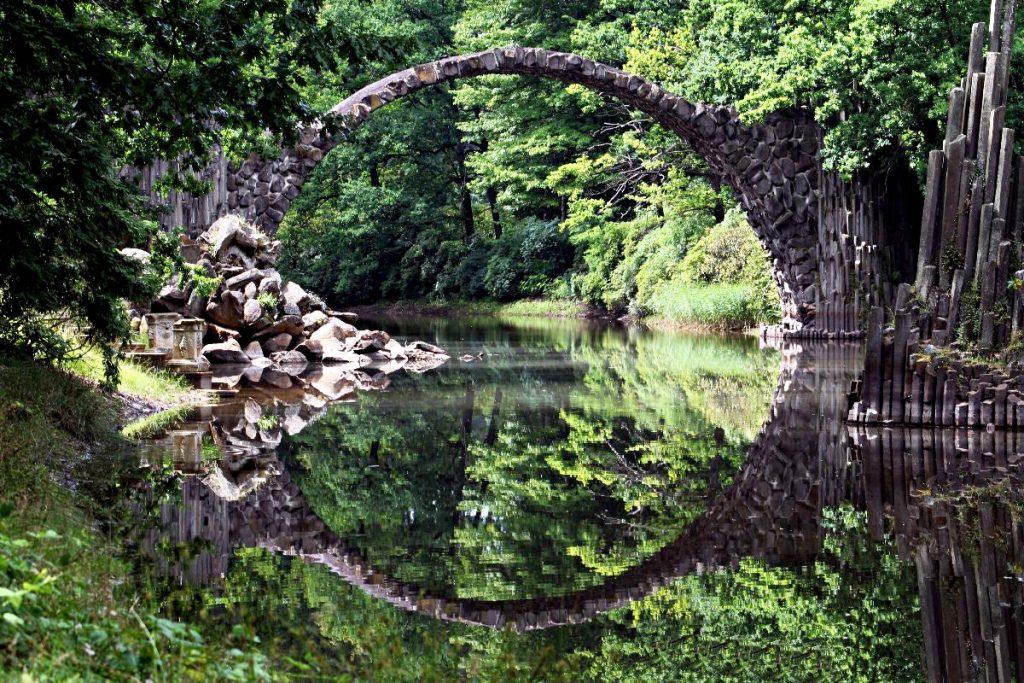The Rakotzbrücke Bridge, also known as the Devil’s Bridge, was built with a premeditated silhouette: an arched bridge that ends up forming a circle, with its own reflection in the water. Topping the ends of the bridge, thin and sharp rock formations further adorn the surroundings, which has nearly two thousand hexagonal basalt columns.
It is said that its unique structure could only have been the work of the Devil himself.
To see this original bridge, framed in a fairytale landscape, you have to go to the Rhododendron Park, one of the largest parks in Saxony, located in the small town of Kromlau in Germany, 138 km from Berlin.
The dark gray stone bridge, typical stone of the place, was built in 1860 to cross the two banks of Lake Rakotzsee. Due to its impressive shape, it acquired the medieval denomination referring to the Devil; in that historical period it was believed that the improbable was the work of the owner of hell.

Friedrich Herrmann Rötschke acquired the Klomlau Mansion in 1842. Shortly after, in 1844, he ordered the construction of one of the largest parks in Saxony, the Rocodendron Park, now known as Kromlauer Park. The Rakotzbrücke bridge was built in the center of this park.
The Kromlauer Park is known for its geological formations but also, it is a true paradise for botany lovers, with unusual varieties such as the eastern black oak, the scarlet oak or the swamp oak. In an extensive area of 200 hectares there are numerous lakes surrounded by azaleas, tulip trees and rhododendrons, among other plants. Currently there are still original trees planted by Rötschke. A water lily pond contains one of the most valuable habitats, with plants such as peatland heather or northern labrador tea.
The park has about ninety hectares for the enjoyment of its visitors, who can access it for free, at any time of the year. If you want to take a guided tour, you can also do it for a small fee.
In addition to the outside of the park you can visit the Mansion, the Kavaliershaus and of course the Rakotzbrücke bridge, its surroundings are the most visited area of the park.

The most recommended time to visit the park is spring, when the varied colors of the flowering turns out to be the best gift for the eyes. If you don’t like crowds of people, you should avoid weekends and summer, as that is when there are a greater number of visitors.
A warning to visitors: the bridge can be seen, but it is forbidden to walk on it.
It is possible to stay overnight in the park, for this there are bungalows and a paid campsite where you can spend the night and make the most of your stay in this place.
The Legend of the Devil’s Bridge
Like other bridges with this same designation, legends surround its origin. One of them tells that a shepherd needed to cross from one bank to the other of the lake. As it was impossible for him to reach, he made a pact with the devil to build him a bridge in the course of the night. In exchange, the devil would charge him by taking the soul of the first one to cross it. Once built, the shepherd tricked the devil by attracting an animal to cross it first. And so the shepherd and all the inhabitants of the place were able to cross the river without the devil taking them with him.
Curiosity: The arched bridges built of stone were invented by the ancient Greeks. Later the Romans used cement in the construction of their arched bridges.
Recommended Hotels
The closest hotels are located around the town of Kromlau. The Kulturhotel Fürst Pückler Park hotel is located near the park and is one of the best rated in the area.
Another recommended place is Hotel Kristall. It is located in Weißwasser, a 5-minute walk from Weißwasser train station.
